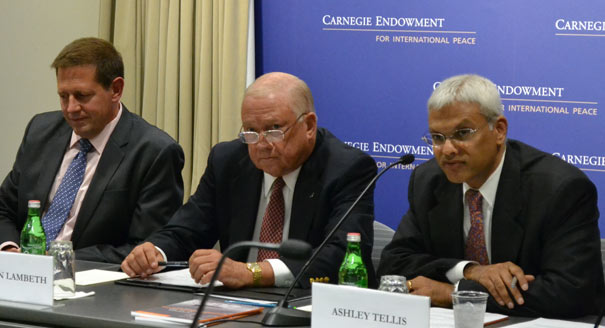Registration
You will receive an email confirming your registration.
IMGXYZ3939IMGZYXThe Kargil-Dras sector, a portion of the disputed state of Jammu and Kashmir, became the focus of international attention in 1999, when a Pakistani incursion into the Indian-administered territory sparked a war. This was significant on multiple levels, including as the most recent ground conflict between two nuclear-armed powers and as an example of high-altitude combat in a mountainous area. In a new Carnegie report, Airpower at 18,000’: The Indian Air Force in the Kargil War, Benjamin Lambeth sheds light on this episode in military history, as well as its implications for India's Himalayan security.
Principal Deputy Assistant Secretary of Defense for Asian and Pacific Security Affairs Peter Lavoy joined Lambeth to discuss the strategic significance of the Kargil conflict and the main threats facing the Indian Air Force in the years to come. Ashley J. Tellis moderated the discussion.
Sudden Conflict
- Delayed Reaction: Lambeth described how the surprise nature of the incursion led to bureaucratic infighting between the Indian Air Force (IAF) and the Indian Army over what role each service would have in repelling the Pakistanis. It took multiple days for the leadership to work out those roles, and the boundaries remained hazy throughout the conflict.
- Hostile Terrain: The IAF had not trained extensively for combat operations in the extraordinary altitudes it faced in Kargil. Lambeth described the new challenges that these conditions presented. Targets were uncommonly hard to spot, and weapons systems behaved differently than at lower altitudes. The mountains also provided opportunities to the IAF, with pilots creatively using air strikes to launch avalanches or rock slides to block Pakistani supply lines.
- Path to Victory: Within a few weeks, the IAF was able to leverage advances in navigation, surveillance, and targeting technology to force a Pakistani retreat. Once India successfully adapted its more advanced Mirage 2000 aircraft to the conflict, Lambeth says, it was all downhill from there.
What it Meant
- Avoiding Escalation: Lambeth observed that this was the first and only serious clash between two nuclear powers that had a clear winner. He attributes much of India’s success in defeating Pakistan without provoking escalation to Prime Minister Atal Vajpayee’s directive not to cross the Kashmiri Line of Control.
- Conventional Asymmetry: Lambeth believes that the significant asymmetry of conventional power favoring India at the time also deterred Pakistan from opening up additional fronts in the war. In particular, he credits the IAF’s far-superior numbers with dissuading its Pakistani counterparts from any attempt to challenge its air superiority.
- Jugaad and Adaptability on the Fly: This conflict also revealed what Lambeth refers to as an essential part of the airman’s culture, which he names using the Hindi word jugaad. Loosely translated, this means “frugal engineering,” and according to Lambeth, it encapsulates the constant technical innovation with limited resources that is required to stay ahead of the curve and come out on top in a conflict like the Kargil War.
Prospects for the Future
- Deterring Further Aggression:Lavoy emphasized that understanding three dynamics is key to avoiding another Kargil going forward: what drives crisis situations once they are in motion; what drives decisionmaking under crisis conditions; and what the respective intentions and capabilities of the combatants are.
- Civil-military and Inter-service Relations: Both Lavoy and Lambeth drew attention to the coordination problems that India faced between the civilian government and the armed forces, as well as among the IAF, the army, and the navy. They stressed the importance of establishing clear command-and-control procedures to deal with rapidly changing situations.
- Reduced Margin for Error? If another conflict were to break out today, Lavoy cautioned that avoiding escalation might be a more difficult feat than it was in 1999. Pakistan now fields a more diverse nuclear arsenal, possibly including weapons designed for tactical battlefield use. That might lead events to unfold much more quickly, leaving less time for de-escalation of tensions.
Image: © Indian Air Force. Used with permission.
